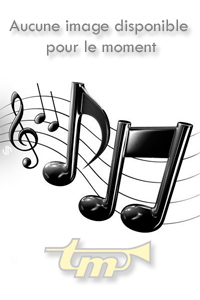Nous utilisons des cookies pour améliorer votre expérience utilisateur. Pour se conformer à la nouvelle directive concernant la vie privée, nous devons vous demander votre consentement pour définir des cookies. En savoir plus.
<< Retour à l'aperçu

Andrea Chénier

Partitions pour orchestre d’harmonie.
| Article no.: | BRZYDAGE02 |
|---|---|
| Compositeur: | Umberto Giordano |
| Arrangeur: | Koh Shishikura |
| Niveau: | 6 |
| Durée: | 13:00 |
| Editeur: | Brain Music |
Disponible dans ces catégories
À partir de
210,00 €
TTC
Disponibilité :
En stockExpédié :
Sous 1 jour ouvrableSelections from the Opera
Umberto Giordano (1867-1948) was the last great composer in Italian romantic opera. His best-known work, Andrea Chénier, is an opera in four acts composed in 1895. Giordano, together with librettist Luigi Illica (who co-produced a number of masterpieces with Puccini) shared in this highly successful collaboration. Andrea Chénier is a hallmark of verismo opera, along with Mascagni's Cavalleria Rusticana and I Pagliacci by Leoncavallo.
The story is based on the life of the French poet André Chénier (1762–1794), executed during the 18th century French Revolution. The first act depicts aristocratic society on the verge of collapse, the second act follows the French Revolution, and the third and fourth acts portray Chénier, accused of treachery. This arrangement selects the most dramatic and beautiful scenes of the entire opera. The opera begins with a charming harp solo and glamorous music at a party in Countess Coigny's mansion. Next an elegant scene with clarinet, horn, harp (rehearsal #2) leads to "O pastorelle, addio!" by a fantasy female chorus (rehearsal #3). At rehearsal #7, lush music from the first and second acts is combined in a scene full of color and vitality. The sound of castanets, anvil and carriage bells is striking. A cadence of tragedy sounds (rehearsal #17), followed by the French national anthem La Marseillaise by an antiphonal trombone duet (rehearsal #18). Hymns representing the citizens' satisfaction after the revolution are sung (rehearsal #19) and conclude with a duet of Chénier and Maddalena's love (rehearsal #23). Please enjoy these endearing highlights from Giordano's wonderful work.
(Koh Shishikura)
Umberto Giordano (1867-1948) was the last great composer in Italian romantic opera. His best-known work, Andrea Chénier, is an opera in four acts composed in 1895. Giordano, together with librettist Luigi Illica (who co-produced a number of masterpieces with Puccini) shared in this highly successful collaboration. Andrea Chénier is a hallmark of verismo opera, along with Mascagni's Cavalleria Rusticana and I Pagliacci by Leoncavallo.
The story is based on the life of the French poet André Chénier (1762–1794), executed during the 18th century French Revolution. The first act depicts aristocratic society on the verge of collapse, the second act follows the French Revolution, and the third and fourth acts portray Chénier, accused of treachery. This arrangement selects the most dramatic and beautiful scenes of the entire opera. The opera begins with a charming harp solo and glamorous music at a party in Countess Coigny's mansion. Next an elegant scene with clarinet, horn, harp (rehearsal #2) leads to "O pastorelle, addio!" by a fantasy female chorus (rehearsal #3). At rehearsal #7, lush music from the first and second acts is combined in a scene full of color and vitality. The sound of castanets, anvil and carriage bells is striking. A cadence of tragedy sounds (rehearsal #17), followed by the French national anthem La Marseillaise by an antiphonal trombone duet (rehearsal #18). Hymns representing the citizens' satisfaction after the revolution are sung (rehearsal #19) and conclude with a duet of Chénier and Maddalena's love (rehearsal #23). Please enjoy these endearing highlights from Giordano's wonderful work.
(Koh Shishikura)
Concert & Festival,Z-YDAG-E02S,Z-YDAG-E02A,BRZYDAGE02S,BRZYDAGE02A
 Français
Français Nederlands
Nederlands  English
English  Deutsch
Deutsch 
